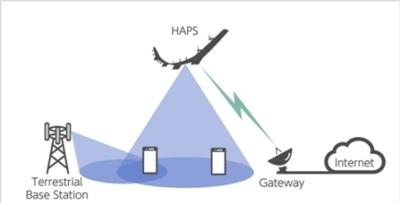New Business To Be Launched Through HAPSMobile
SoftBank has launched a High Altitude Platform Station (HAPS) business through HAPSMobile, a joint venture between SoftBank and U.S.-based company AeroVironment.

With the aim of constructing a HAPS system that delivers telecommunications network connectivity from the sky for a global business, HAPSMobile developed “HAWK30,” an unmanned aircraft for stratospheric telecommunications platform system that flies at altitudes of approximately 65,000 feet.
HAPS refers to systems where unmanned objects such as aircraft flying in the stratosphere can be operated like telecommunication base stations to deliver connectivity across wide areas. By utilizing HAPS, SoftBank will be able to build stable Internet connection environments at locations unserved by telecommunication networks, such as mountainous terrain, remote islands and developing countries. Furthermore, by efficiently interconnecting with current telecommunication networks, SoftBank will be able to realize wide-area connectivity that spans both the sky and the ground to enable drone utilization, as well as contribute to the adoption of IoT and 5G. Since HAPS can provide stable telecommunications networks without being affected by situations on the ground, the technology is also expected to help assist rescue and recovery efforts during times of disasters.
“HAWK30”, the unmanned aircraft for stratospheric telecommunications platform developed by HAPSMobile, measures approximately 78 meters long. Powered by solar panels on its wings that house 10 propellers, “HAWK30” can fly at speeds of approximately 60 knots on average. Since “HAWK30” flies at high altitudes above the clouds, its solar panels are continually powered by sunlight. “HAWK30” can also be flown for long periods that range up to a number of months since it takes advantage of the stratosphere’s climate, which sees winds that are relatively gentle year-round.

The telecommunications network to be delivered to the ground by “HAWK30” is expected to use a system that does not interfere with the networks of terrestrial base stations. Furthermore, smooth handovers between networks provided by terrestrial base stations and by “HAWK30” will also be possible. As a result, communication disruption will not occur even when a person using a smartphone moves from a base station covered area to a “HAWK30” covered area.
With a view to providing sky-based telecommunications networks that utilize HAPS globally, HAPSMobile will conduct research and development and flight tests while coordinating with the relevant authorities in various countries and giving consideration to business-related regulations. HAPSMobile is targeting 2023 for “HAWK30” mass production and service launch.
The HAPS business is being positioned as an initiative for SoftBank’s “Beyond Japan” strategy that takes insights from successful businesses from Japan to the global stage. By providing innovative services and deploying global businesses, SoftBank aims to maximize corporate value.
(Image provided with HAPSMobile news release)
 ANN's Daily Aero-Linx (05.02.24)
ANN's Daily Aero-Linx (05.02.24) ANN's Daily Aero-Term (05.02.24): Touchdown Zone Lighting
ANN's Daily Aero-Term (05.02.24): Touchdown Zone Lighting Aero-News: Quote of the Day (05.02.24)
Aero-News: Quote of the Day (05.02.24) ANN FAQ: Contributing To Aero-TV
ANN FAQ: Contributing To Aero-TV NTSB Final Report: Cirrus Design Corp SR20
NTSB Final Report: Cirrus Design Corp SR20




